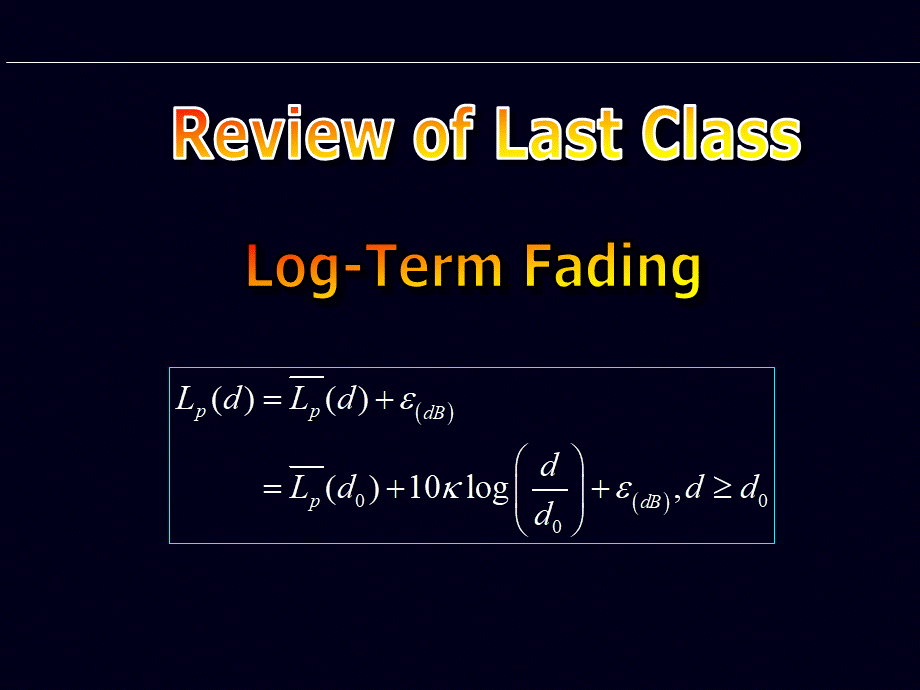无线通信基础(双语)-教学课件-6.ppt
《无线通信基础(双语)-教学课件-6.ppt》由会员分享,可在线阅读,更多相关《无线通信基础(双语)-教学课件-6.ppt(64页珍藏版)》请在冰点文库上搜索。

ReviewofLastClass,Log-TermFading,ReviewofLastClass,RadioCellCoverage,WithoutshadowingWithshadowing,ReviewofLastClass,OkumuraModel,5、Indoor/OutdoorPathLossModel,OkumuraModelOkumura-HataPathLossModelCOST231ModelLeesPathLossModel,EmpiricalformulationtomatchOkumuramodelSuitableforlargecell,5、Indoor/OutdoorPathLossModel,Okumura-HataPathLossModel,ThepathlossisrepresentedasafunctionofThecarrierfrequency,150,1500MHzAntennaheightsofbasestationandmobilestation,hb30,200m,hm1,10mThedistancebetweenthebasestationandmobilestation,1,20Km,5、Indoor/OutdoorPathLossModel,Okumura-HataPathLossModel,ThepathlossindBisgivenby,where,5、Indoor/OutdoorPathLossModel,Okumura-HataPathLossModel,a(hm)isthecorrectionfactorformobileantennaheight,andisgivenby,Forasmallandmediumcity,Foralargecity,5、Indoor/OutdoorPathLossModel,Okumura-HataPathLossModel,fc=900MHzhb=50mhm=3m,5、Indoor/OutdoorPathLossModel,Okumura-HataPathLossModel,TheHatamodelwasextendedbytheEuropeancooperativeforscientificandtechnicalresearch(EURO-COST)to2GHz,Wherea(hr)isthesamecorrectionfactorasbeforeandCMis0dBformediumsizedcitiesandsuburbsand3dBformetropolitanareas.,5、Indoor/OutdoorPathLossModel,COST231Model,TheCOST231modelisrestrictedtothefollowingrangeofparameters:
Thecarrierfrequency,1.5,2GHzAntennaheightsofbasestationandmobilestation,hb30,200m,hm1,10mThedistancebetweenthebasestationandmobilestation,1,20Km,5、Indoor/OutdoorPathLossModel,COST231Model,Leesmodelcanbeusedtopredictarea-to-areapathloss.Themodelconsistsoftwoparts:
PathlosspredictionforaspecifiedsetofconditionsAdjustmentfactorsforasetofconditionsdifferentfromthespecifiedoneThemodelrequirestwoparameters:
Thepowerata1.6km(1mile)ofinterceptionP0indBmThepath-lossexponentk.,5、Indoor/OutdoorPathLossModel,LeesPathLossModel,Thespecifiedsetofconditionsisasfollows:
Carryfrequencyfc=900MHzBasestationantennaheight=30.48m(100ft)Basestationpowerattheantenna=10WBasestationantennagain=6dBabovedipolegainMobilestationantennaheight=3m(10ft)Mobilestationantennagain=0dBabovedipolegain,5、Indoor/OutdoorPathLossModel,LeesPathLossModel,5、Indoor/OutdoorPathLossModel,LeesPathLossModel,ThereceivedsignalpowerindBmisrepresentedby:
Whered0=1.6km,d(d0)isthedistancebetweenthemobilestationandthebasestationinkm,andnisaconstantbetween2and3dependentonthegeographicallocationsandtheoperatingfrequencyranges.n=2isrecommendedforasuburbanoropenareawithf450MHz.,5、Indoor/OutdoorPathLossModel,LeesPathLossModel,Theparametera0(dB)isanadjustmentfactorforadifferentsetofconditions:
Where,5、Indoor/OutdoorPathLossModel,LeesPathLossModel,Theparametera0(dB)isanadjustmentfactorforadifferentsetofconditions:
Where,5、Indoor/OutdoorPathLossModel,LeesPathLossModel,Thevaluevina2isobtainedfromempiricaldataandisgivenby:
A2dBsignalgainisprovidedbyanactual4dBgainantennaatthemobileunitinasuburbanarea,andlessthan1dBgainreceivedfromthesameantennainanurbanareaforadjustinga5.,5、Indoor/OutdoorPathLossModel,LeesPathLossModel,5、Indoor/OutdoorPathLossModel,LeesPathLossModel,fc=900MHzhb=50mAntennagain=6dBTransmitterpower=10Whm=3m,5、Indoor/OutdoorPathLossModel,LeesPathLossModel,ReviewofSection2.4,Free-spacepropagationTwo-raygroundreflectionmodelLog-distancepathlossmodelLog-normalpathlossmodelOkumuraHatamodel,Leesmodel,Receivedpowerreduceswithpropagationdistanceandterraincharacteristicsmodels,Keepinmindwhenstudyingsection2.4:
Thechannelmodelisindependentofsignals,symbolrate,modulation,etc.,Channel&signal:
Differentsignalsmayseedifferentaspectofchannel.,Thechannelfadingcanbeclassifiedaslarge-scalefadingorsmall-scalefading.Large-scalefading:
Duetothegeneralterrainandthedensityandheightofbuildingandvegetation;characterizedstatisticallybythemedianpathlossandlognormalshadowing,variesrelativelyslowlywithtime.Small-scalefading:
Duetothelocalenvironment,signalvariabilityonascaleof,havebeencharacterizedstatisticallyasinstantaneouslyreceivedsignallevelvariationswiththelocalaverage.,Shadowingorlognormalfading,TimedelayspreadTime-varying,Inthissection,wemadetheassumptionthatthechannelwaslinear,accordingtothisassumption,alldistortionscanbecharacterizedbytheattenuationorsuperpositionofdifferentsignals.Inaddition,weallowthepossibilitythatthepropagationchannelmaybetimevarying.Asaconsequenceoftheseassumptions,thechannelcanbepresentedbyadualtimetime-varyingimpulseresponse,definedasLineartime-variantchannel.,Chapter2-Lecture5,Lineartime-variantchannelmodel,2.2Lineartime-variantchannelmodel,2.2.2Time-VariantTransferFunction,2.2.4ExampleontheChannelFunctions,2.2.1ChannelImpulseResponse,2.2.3DopplerSpreadFunctionandDelay-Dopplerspreadfunction,2.2Lineartime-variantchannelmodel,1、ChannelImpulseResponse,BasebandEquivalentChannelModelLinearTime-Variant(LTV)Channel,1、ChannelImpulseResponse,ConsideramultipathpropagationenvironmentwithNdistinctscatters.Thepathassociatedwiththenthdistinctscatterischaracterizedby:
representstheamplitudefluctuationbythescatterattimet,associatedpropagationdelay,BasebandEquivalentChannelModel,Consideranarrowbandsignaltransmittedoverthewirelesschannelatacarrierfrequencyfc,suchthat,Andthereceivedsignalatthechanneloutputis,BasebandEquivalentChannelModel,1、ChannelImpulseResponse,1、ChannelImpulseResponse,BasebandEquivalentChannelModel,1、ChannelImpulseResponse,BasebandEquivalentChannelModel,Thechannelcanbecharacterizedequivalentlybyitsimpulseresponseatbaseband.,1、ChannelImpulseResponse,BasebandEquivalentChannelModel,Letusfirstreviewtheimpulseresponseofalineartime-invariant(LTI)channel,Thetimevariabletintheimpulseresponseactuallyrepresentsthepropagationdelayofthechannel,1、ChannelImpulseResponse,LinearTime-Variant(LTV)Channel,1、ChannelImpulseResponse,LinearTime-Variant(LTV)Channel,Time-varyingDiscreteImpulseResponseModelformultipathchannel,1、ChannelImpulseResponse,LinearTime-Variant(LTV)Channel,Definition2.1TheimpulseofanLTVchannel,h(,t),isthechanneloutputattinresponsetoanimpulseappliedtothechannelatt-.,Indefinition2.1,thevariablerepresentsthepropagationdelay.Thus,thechanneloutputcanberepresentedintermsoftheimpulseresponseandthechannelinputby,1、ChannelImpulseResponse,LinearTime-Variant(LTV)Channel,TheChannelimpulseresponseforthechannelwithNdistinctscattersisthen,1、ChannelImpulseResponse,LinearTime-Variant(LTV)Channel,Example2.9,1、ChannelImpulseResponse,Example2.10,Sameas2.9,butreceivermoveatv=10m/stowardpath#1whileawayfrompath#2.Whatisthechannelattimet=0.1s?
Carrieris1GHz.,1、ChannelImpulseResponse,ReviewofLastClass,Free-spacepropagationTwo-raygroundreflectionmodelLog-distancepathlossmodelLog-normalpathlossmodelOkumuraHatamodel,Leesmodel,ReviewofLastClass,LinearTime-Variant(LTV)Channel,Channelimpulseresponse,Fouriertransform,ChannelTransferFunction,h(t),H(f),h(,t),?
2.2Lineartime-variantchannelmodel,2、Time-VariantTransferFunction,Definition2.2Thetime-varianttransferfunctionofanLTVchannelistheFouriertransformoftheimpulseresponse,h(,t),withrespecttothedelayvariable.,Wherethetimevariabletcanbeviewedasaparameter.,2、Time-VariantTransferFunction,2、Time-VariantTransferFunction,Atanyinstant,sayt=t0,thetransferfunctionH(f,t0)characterizesthechannelinthefrequencydomain.Asthechannelchangeswitht,thefrequencydomainrepresentationalsochangeswitht.Therefore,wehavethechanneltime-varyingtransferfunction.,2、Time-VariantTransferFunction,Ingeneral,theoutputsignalofanLTIsystemdoesnothavefrequencycomponentsdifferentfromthoseoftheinputsignalOntheotherhand,bothnonlinearandtime-varyingsystemsintroducenewfrequencycomponentsotherthanthoseexistingintheinputsignal.,LinearTime-VariantChannel,DopplereffectDopplershifts,2.2Lineartime-variantchannelmodel,3、DopplerSpreadFunctionandDelay-DopplerspreadFunction,DopplerShiftinfrequency:
wherevisthemovingspeed,isthewavelengthofcarrier.,Asawirelesschannelcanbecharacterizedequivalentlyinbothtimeandfrequencydomains,achannelbeingtimevaryinginthetimedomainmeansachannelintroducingDopplershiftsinthefrequencydomain.,3、DopplerSpreadFunctionandDelay-DopplerspreadFunction,DopplerShift,AssumeThatthedelayspreadisnegligibleascomparedwiththesymbolintervalofthetransmittedsignal.ThatthismeandelaydoesnotchangewithtimeThetime-variantimpulseresponseofthechannelcanbeapproximatelydescribedintheform:
Where,3、DopplerSpreadFunctionandDelay-DopplerspreadFunction,Spectralbroadening,Giventhatthetransmittedsignalisx(t),thereceivedsignalis,3、DopplerSpreadFunctionandDelay-DopplerspreadFunction,Spectralbroadening,Infrequencydomain,thereceivedsignalis,Hasafinitebutnonzeropulsewidthinthefrequencydomain,3、DopplerSpreadFunctionandDelay-DopplerspreadFunction,Spectralbroadening,Thismeansthatthechannelindeedbroadensthetransmittedsignalspectrumbyintroducingnewfrequencycomponents,aphenomenonreferredtoasfrequencydispersion.,3、DopplerSpreadFunctionandDelay-DopplerspreadFunction,Spectralbroadening,Definition:
TheDopplerspreadfunctionisdefinedbythefollowingfunction:
where:
visavariabledescribingtheDopplershiftintroducedbythechannel.H(f,v)isthechannel